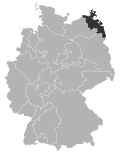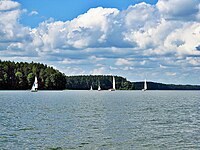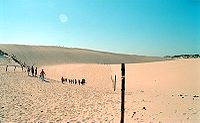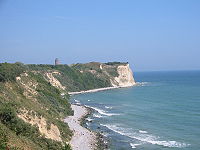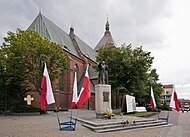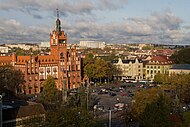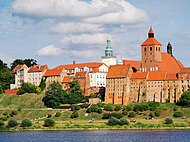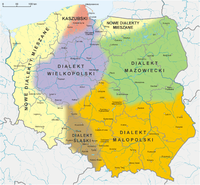Pomerania
Pomerania
Pomorze, Pommern, Pòmòrskô | |
|---|---|
Historical region | |
Toruń Old Town | |
|
UTC+2 (CEST) | |
| Primary airports | Gdańsk Lech Wałęsa Airport Solidarity Szczecin–Goleniów Airport |
| Highways | |
Pomerania (
Pomerania's historical border in the west is the Mecklenburg-Western Pomeranian border Urstromtal,[a] which now constitutes the border between the Mecklenburgian and Pomeranian part of Mecklenburg-Western Pomerania, while it is bounded by the Vistula River in the east. The easternmost part of Pomerania is alternatively known as Pomerelia, consisting of four sub-regions: Kashubia inhabited by ethnic Kashubians, Kociewie, Tuchola Forest and Chełmno Land.
Pomerania has a relatively low population density, with its largest cities being Gdańsk and Szczecin. Outside its urban areas, it is characterized by farmland, dotted with numerous lakes, forests, and small towns. In the west of Pomerania lie several islands, the largest of which are Rügen, the largest island in Germany; Usedom/Uznam, and Wolin, the largest island in Poland. The region has a rich and complicated political and demographic history at the intersection of several cultures.
Geography

Borders
Pomerania is the area along the Bay of Pomerania of the Baltic Sea between the rivers Recknitz, Trebel, Tollense and Augraben in the west and Vistula in the east.[1][2] It formerly reached perhaps as far south as the Noteć river, but since the 13th century its southern boundary has been placed further north.
Landscape
Most of the region is coastal lowland, being part of the
The western coastline is jagged, with many peninsulas (such as
The eastern coastline is smooth.
Subregions
The Pomeranian region has the following administrative divisions:
- Mecklenburg-Western Pomerania. The southernmost part of historical Western Pomerania (the Gartz area) is now in Brandenburg, while its historical eastern parts (the Oder estuary) are now in Poland. Western Pomerania comprises the historical regions inhabited by Western Slavic tribes Rugians and Volinians,[citation needed] otherwise the Principality of Rügen and the County of Gützkow.
- The West Pomeranian Voivodeship (Zachodniopomorskie) in Poland, stretching from the Oder–Neisse line to the Wieprza river, encompassing most of historical Pomerania in the narrow sense (as well as small parts of historic Greater Poland and Lubusz Land).
- The Pomeranian Voivodeship, with similar borders to Pomerelia, stretching from the Wieprza river to the Vistula delta in the vicinity of Gdańsk.
- The northern half of the Kuyavian-Pomeranian Voivodeship, comprising most of Tuchola Forest and Chełmno Land.
The bulk of
Parts of Pomerania and surrounding regions have constituted a
-
Pomerania (Pomorze) and other historical lands of Poland against the background of modern administrative borders (names in Polish)
-
The German part of Pomerania
-
The border between Pomerania and Mecklenburg running through Mecklenburg-Vorpommern
-
Słowiński National Park(Pomeranian Voivodeship)
-
Typical Pomeranian beach (West Pomeranian Voivodeship)
-
Wolin National Park (West Pomeranian Voivodeship)
-
Cape Arkona (Mecklenburg-Vorpommern/Western Pomerania)
Nomenclature
Etymology
In
Earliest sources
Pomerania was first mentioned in an
Terminology and attribution of subdivisions
The territorial designation "Pomerania" lacks a universally accepted definition, since it may refer either to combined Hither and Farther Pomerania only (in German contemporary and historical usage[4]) or to Hither and Farther Pomerania combined with Pomerelia (in Polish contemporary and historical usage).
As a consequence, the term "West Pomerania" is ambiguous, since it may refer to either Hither Pomerania (in German usage and historical usage based on German terminology[4]), or to combined Hither and Farther Pomerania (in Polish usage and historical usage based on German terminology). In parallel, the term "East Pomerania" may similarly carry different meanings, referring either to Farther Pomerania (in German usage and historical usage based on German terminology[4]), or to Pomerelia (in Polish usage and historical usage based on German terminology).
As a further complication, the borders of the eponymous administrative units have been drawn disregarding mostly the historical ones. The Polish unit called województwo zachodniopomorskie (
| West | Pomerania | East | Southeast | ||||||||||||||||||
| Ahrenshoop (westernmost Pomeranian settlement), Ribnitz-Damgarten (Damgarten only), Saal, Prerow, Zingst, Barth, Tribsees, Franzburg, Richtenberg, Grimmen, Stralsund, DÄNHOLM |
Loitz, Gützkow, Greifswald, Lubmin, Kröslin, RUDEN, GREIFSWALDER OIE, Wolgast, Lassan |
Kummerow, Sommersdorf, Verchen, Demmin, Altentreptow |
Alt Tellin, Jarmen, Anklam |
Ahlbeck
|
Pasewalk, Torgelow, Ueckermünde, Eggesin, Löcknitz, Penkun, Altwarp, Pomellen (easternmost settlement in M.-V.) |
Gartz (Oder), (easternmost Pomeranian settlement in Germany)
Mescherin |
(left-bank) | Goleniów, Police, Nowe Warpno, Szczecin, Dąbie |
Widuchowa, Gryfino, Banie, Pyrzyce |
Świdwin, Połczyn-Zdrój, Kalisz Pomorski, Drawsko Pomorskie, Złocieniec, Kołobrzeg, Koszalin, Polanów, Sianów, Karlino, Tychowo, Bobolice, Białogard, Biały Bór, Szczecinek, Sławno, Darłowo |
Ustka, Słupsk, Miastko |
Łeba, Lębork, Bytów (Lauenburg and Bütow Land German: Lande Lauenburg und Bütow Polish: Ziemia lęborsko-bytowska) |
Człuchów, Chojnice, Kościerzyna, Kartuzy, Żukowo, Puck, Władysławowo, Jastarnia, Hel |
Wejherowo, Reda, Rumia, (so-called Little Kashubian Tricity) Gdynia, Sopot, Gdańsk (Tricity) Pruszcz Gdański, Nowy Staw, Krynica Morska |
Starogard Gdański, Skarszewy, Pelplin, Tczew, Gniew |
Świecie, Nowe |
Tuchola, Pruszcz |
Toruń, Grudziądz, Chełmno, Chełmża, Wąbrzeźno, Kowalewo Pomorskie, Jabłonowo Pomorskie, Radzyń Chełmiński, Łasin, Brodnica (part north of Drwęca with historic center), Golub | |||
| Current countries | Germany | Poland | |||||||||||||||||||
| Current administrative regions | Mecklenburg-Vorpommern (Mecklenburg-Western Pomerania) |
Brandenburg | województwo zachodniopomorskie (West Pomeranian Voivodeship) |
województwo pomorskie (Pomeranian Voivodeship) |
województwo kujawsko-pomorskie ( Kuyavian-Pomeranian Voivodeship )
| ||||||||||||||||
| Vorpommern-Rügen | Vorpommern-Greifswald | Mecklenburgische Seenplatte | Vorpommern-Greifswald | Uckermark | |||||||||||||||||
| German terminology (corresponding English term) |
Pommern[1] (Pomerania) bounded in the west by the Recknitz, Trebel and Lake Kummerow, and in the east by the Piaśnica |
Pomerellen, Pommerellen[1] (Pomerelia)[1] After Partitions of Poland, part of the wider Westpreussen (West Prussia) before Partitions of Poland, part of the wider Königlich-Preußen or Preußen Königlichen Anteils (Royal Prussia) | |||||||||||||||||||
| Vorpommern (Hither Pomerania, Fore Pomerania) in modern usage the part located in Germany only |
Hinterpommern (Farther/Further Pomerania, Rear Pomerania) |
Kaschubei[5] (Kashubia) areas south-east of Könitz (Schwarzwasser, Czersk): Tucheler Heide (Tuchola Forest), Koschneiderei |
Kociewie | Tucheler Heide (Tuchola Forest), Koschneiderei |
Kulmerland (Chełmno Land) | ||||||||||||||||
| Neuvorpommern (New Hither Pomerania) western part of Swedish Pomerania that went from Sweden to Prussia in 1815 |
Altvorpommern (Old Hither Pomerania) eastern part of Swedish Pomerania that went from Sweden to Prussia in 1720 | ||||||||||||||||||||
| Westpommern (Western Pomerania) mainland west of the Zarow and Rügen archipelago |
Mittelpommern (Middle Pomerania) mainland east of the Zarow as well as Usedom and Wolin |
Ostpommern (Eastern Pomerania) | |||||||||||||||||||
| Mittelpommerscher Keil (Middle Pomeranian Wedge) excluding Uznam and Wolin
|
|||||||||||||||||||||
| Polish terminology (corresponding English term) |
Pomorze Zachodnie (Western Pomerania) Pomorze Nadodrzańskie (Oder Pomerania) |
Pomorze Wschodnie (Eastern Pomerania) Pomorze Nadwiślańskie (Vistula Pomerania) before World War II simply Pomorze[1] (Pomerelia,[1] literally Pomerania) before Partitions of Poland, part of the wider Prusy Królewskie (Royal Prussia) | |||||||||||||||||||
| Pomorze Zaodrzańskie (Trans-Oder Pomerania) Pomorze Wołogoskie (Wołogoszcz or German: Wolgast Pomerania) |
Pomorze Szczecińskie (Szczecin Pomerania) Pomorze Zachodnie w węższym znaczeniu (Western Pomerania in narrower sense) |
Pomorze Środkowe (Middle Pomerania) Pomorze Koszalińsko-Słupskie (Koszalin and Słupsk Pomerania) |
Pomorze Gdańskie (Gdańsk Pomerania) |
Ziemia chełmińska (Chełmno Land) ethnocultural region | |||||||||||||||||
| Pomorze Przednie (Hither Pomerania, Fore Pomerania) in modern usage the part located in Germany only |
Pomorze Tylne (Farther/Further Pomerania, Rear Pomerania) usage limited mainly to translations of German texts |
Kaszuby (Kashubia) ethnocultural region areas south-east of Chojnice (Czarna Woda, Czersk): Bory Tucholskie (Tuchola Forest) ethnocultural region, Kosznajderia former ethnocultural region |
Kociewie ethnocultural region |
Bory Tucholskie (Tuchola Forest) ethnocultural region, Kosznajderia former ethnocultural region | |||||||||||||||||
| Kashubian terminology (corresponding English term) |
Zôpadnô Pòmòrskô (Western Pomerania) |
Lãbòrskò-bëtowskô Zemia ( Lębork and Bytów Land ) |
Pòrénkòwô Pòmòrskô (Eastern Pomerania) | ||||||||||||||||||
| Kaszëbë (Kashubia ethnocultural region) |
Kòcéwskô (Kociewie) ethnocultural region |
Tëchòlsczé Bòrë (Tuchola Forest) ethnocultural region, Kòsznajderiô (Kosznajderia) former ethnocultural region |
Chełmińskô Zemia (Chełmno Land) ethnocultural region | ||||||||||||||||||
History
| History of Pomerania |
|---|
 |
|
|
Prehistory to the Middle Ages (circa 400 A.D. – 1400 A.D.)
Settlement in the area called Pomerania for the last 1,000 years started by the end of the
In the 12th century, the
Renaissance (circa 1400–1700) to Early Modern Age

In 1466, with the
Modern Age
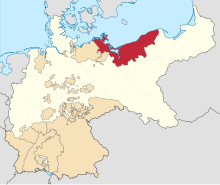


Following the German Empire's defeat in World War I, however, eastern Pomerania/Pomerelia was returned to the rebuilt Polish state, while German-majority Gdańsk/Danzig was transformed into the independent Free City of Danzig. In the interbellum, the border with Poland and the creation of what German propaganda called the "Polish Corridor" were often contested in Germany. Irredentist claims towards Poland were one of the factors contributing to the rise of the Nazi Party in Germany. In 1938 Germany's Province of Pomerania was expanded to include northern parts of the former Province of Posen–West Prussia (part of historic Greater Poland).
Under the
World War II

In September 1939, Germany
After
Pomeranian dialect and traditions still live in the country of Brazil in a colony where the language is still spoken. The arrival of Pomerania immigrants with Germans and Italians helped form the state of Espírito Santo since the early 1930s.[43] Their importance and respect are one of the cultural signatures of the area. The Brazilian city of Pomerode (in the state of Santa Catarina) was founded by Pomeranian Germans in 1861 and is considered the most typically German of all the German towns of southern Brazil.
Demographics
The German part of
German
Pomerelia is dominated by the Tricity metropolitan area (Pomeranian Voivodeship) with its population in 2012 estimated at least at 1,035,000 and the area at 1,332,51 km2, encompassing the Tricity itself with a population of 748,986 combining the eponymous three cities of Gdańsk (population 460,427), Gdynia (population 248,726) and Sopot (population 38,217), as well as the Little Kashubian Tricity with a population of 120,158 people (2012), formed by the City of Wejherowo (population 50,310 in 2012) and the towns (urban gminas) of Rumia (population 49,230 in 2020) and Reda (population 26,011 in 2019). The area also includes two smaller towns of Żukowo and Pruszcz Gdański belonging to the eponymous urban-rural gminas, and a number of rural gminas.
| Region | Seat | Registration plates |
Area (km2) |
Population (Poland 2019/2021, Germany 2022) |
| West Pomeranian Voivodeship | Szczecin | Z | 22,892 | 1,682,003 |
| Pomeranian Voivodeship | Gdańsk | G | 18,293 | 2,337,769 |
Kuyavian-Pomeranian Voivodeship Pomeranian part only |
Toruń Voivod council Bydgoszcz Voivod office; not in Pomerania |
C | 11,980 | 1,124,517 |
| Polish Pomerania | 53,165 | 5,144,289 | ||
Landkreis Vorpommern-Greifswald
|
Greifswald | VG, ANK, GW, HGW, PW, SBG, UEM, WLG | 3,927 | 237,355 |
Landkreis Vorpommern-Rügen
|
Stralsund | VR, GMN, HST, NVP, RDG, RÜG | 3,188 | 227,683 |
Landkreis Mecklenburgische Seenplatte
|
Demmin | MSE, AT, DM, MC, MST, MÜR, NZ, RM, WRN | 443 | 17,301 |
Landkreis Mecklenburgische Seenplatte
|
Altentreptow | MSE, AT, DM, MC, MST, MÜR, NZ, RM, WRN | 414 | 13,581 |
Landkreis Uckermark, Brandenburg
|
Gartz (Oder)
|
UM, ANG, PZ, SDT, TP | 264 | 6,682 |
Landkreis Uckermark, Brandenburg ; Pomeranian parts only: Hohenfelde, Jamikow, Kummerow, Kunow, Schönow
|
Schwedt/Oder
|
UM, ANG, PZ, SDT, TP | 71 | 1,028 |
Landkreis Mecklenburgische Seenplatte; historically a Pomeranian enclave of seven villages (the Säben Dörper), southeast of Malchin, surrounded by Mecklenburg
|
Zettemin | MSE, AT, DM, MC, MST, MÜR, NZ, RM, WRN | 19 | 267 |
| German Pomerania | 8,326 | 503,897 | ||
| Pomerania | 61,491 | 5,648,186 | ||
Cities in Pomerania
Altogether, there are 16 cities in the broad-sense Pomerania, understood as comprising also Pomerelia. Their list is presented below and includes the 14 municipalities in Poland electing a city mayor (Polish: prezydent miasta) instead of a town mayor (Polish: burmistrz), with 9 of them holding the status of a city with powiat rights (Polish: miasto na prawach powiatu, an independent city), as well as the 2 municipalities in Germany holding the status of a district-belonging city (German: Große kreisangehörige Stadt), as no city of the German part of Pomerania holds currently any higher status, such as a partially of fully independent city (German: Große selbständige Stadt, Kreisfreie Stadt, or Stadtkreis), or a city-state (German: Stadtstaat).
Cities in the historical region of Hither Pomerania
- Szczecin (city with powiat rights, West Pomeranian Voivodeship): 394,482; up to 763,321 in the metropolitan area[44]
- Greifswald, in Low German Griepswohld (Vorpommern-Greifswald, Mecklenburg-Vorpommern): 59,332
- Stralsund (Vorpommern-Rügen, Mecklenburg-Vorpommern): 59,171
- Świnoujście (city with powiat rights, West Pomeranian Voivodeship); 39,834
- Schwedt/Oder (Uckermark, Brandenburg) expanded in contemporary times, so that it now also encompasses some neighbourhoods north of the Welse, the historical border river between Brandenburg and Pomerania (Blumenhagen, Gatow, Hohenfelde, Jamikow, Kummerow, Kunow, Schönow and Vierraden): 33,524
Cities in the historical region of Farther Pomerania
- Koszalin (city with powiat rights, West Pomeranian Voivodeship): 109,343
- Słupsk (city with powiat rights, Pomeranian Voivodeship): 94,849
- Stargard (Stargard County, West Pomeranian Voivodeship): 69,724
- Kołobrzeg (Kołobrzeg County, West Pomeranian Voivodeship); 46,259
Cities in the historical region of Pomerelia
- Tricity (Pomeranian Voivodeship): 748,986; the Tricity metropolitan area (Pomeranian Voivodeship): population in 2012; at least 1,035,000 area 1,332,51 km2
- Gdańsk (city with powiat rights, Pomeranian Voivodeship): 460,427
- Gdynia (city with powiat rights, Pomeranian Voivodeship): 248,726
- Sopot (city with powiat rights, Pomeranian Voivodeship): 38,217
- Kuyavian-Pomeranian Voivodeship): 205,934
- Grudziądz (city with powiat rights, Kuyavian-Pomeranian Voivodeship): 96,042
- Tczew (Tczew County, Pomeranian Voivodeship): 60,279
- Wejherowo (Wejherowo County, Pomeranian Voivodeship): 50,375
- Starogard Gdański (Starogard County, Pomeranian Voivodeship): 44,470
Culture
Languages and dialects
Polish is the dominating language in the Polish part of Pomerania. Kashubian dialects are also spoken by the Kashubians in Pomerelia.
In the German part of Pomerania,
Those parts of Pomerania that remained German after 1945 are almost entirely located in the
East Pomeranian,
-
A map of Polish dialects. The Pomorze region contains the Kashubian language and a mix of Polish dialects from other parts of the country.
-
Pomerania historically lay in theLow Prussian.
-
The Central Pomeranian dialect region of Low German, east of the Zarow and north of the Welse, where "Ohren" (ears) is pronounced like "oan" and "orn" (now bounded by the Oder-Neisse line in the east)
Cuisine
- For typical food and beverages of the region, see Pomeranian cuisine.
Museums
Museums in the Polish part
At least 50 museums in Poland cover the history of Pomerania, the most important of them being the
, and the Museum of Maritime Fisheries in Świnoujście.Other notable museums include the Museum of the National Anthem (Muzeum Hymnu Narodowego) in
Several museums devoted to World War II history are located in Polish Pomerania, including the Museum of the Second World War in Gdańsk, the Guardhouse no. 1 at Westerplatte (a branch of the Museum of Gdańsk), the Museum of Coastal Defence in Hel, the Stutthof Museum in Sztutowo with the branch Piaśnica Museum in Wejherowo, the Museum of the Pomeranian Wall and World War II in Szczecinek, and the Armory Museum in Kłanino.
There are also aquaria: the Gdynia Aquarium and the Seal Sanctuary in Hel.
Perhaps more unusual museums include the Amber Museums in Gdańsk and
Museums in the German part
There are around 40 museums in the district of Vorpommern-Rügen, the most notable of which are:
- the "Foundation German Oceanographic Museum" in Stralsund, which runs four locations: the Natureum in Born auf dem Darß.
- the Svantevit Stone, the Hiddensee treasureand the Peenemünde gold rings.
- the Navy Museum Dänholm (Marinemuseum Dänholm), the Dänholm being the cradle of the German Navy.
- the German Amber Museum in Order of Saint Clarein Ribnitz.
- the Bibelzentrum Bogislaw XIII, Duke of Pomerania.
- the Granitz Hunting Lodge with among others, the exhibition "Deers of the world" is Mecklenburg-Vorpommern's most visited castle.
- the West Pomeranian Potato Museum in Tribsees, one of three German potato museums.
- the crane museum (Kranich Museum) in Saal, dedicated to all kinds of cranes.
In the district of Vorpommern-Greifswald are located around 30 museums, among which:
- the Pomeranian State Museum, the collections of which include the famous Croÿ-Carpet and various paintings by Caspar David Friedrich and Vincent van Gogh.
- the Peenemünde Historical Technical Museum, where the only rockets in the territory of Pomerania are exhibited.
- the Museumshafen Greifswald is Germany's largest museum harbour.
- Ukranenland, an archaeological open-air museum on the banks of the Uecker in Torgelow, which is modeled on an early medieval Slavic village. It depicts the life of the Ukrani, the Elbe Slavic tribe once native to the Uckermark.
Education
Universities
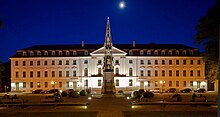
There are four traditional (non-profiled and multi-faculty, public research) universities in the region, namely the University of Greifswald, the University of Szczecin, the University of Gdańsk and the Nicolaus Copernicus University in Toruń, the oldest of which, the University of Greifswald, was founded when Greifswald belonged to Duchy of Pomerania, thus being one of the oldest universities in the world.
The technical universities are the Gdańsk University of Technology, West Pomeranian University of Technology in Szczecin, and Koszalin University of Technology.
University of Applied Sciences
The Stralsund University of Applied Sciences (Hochschule Stralsund) in Stralsund has around 2,400 students.
Economy
Agriculture primarily consists of raising livestock, forestry, fishery, and the cultivation of
around research facilities of the Pomeranian universities.Since the late 19th century, tourism has been an important sector of the economy, primarily in the numerous seaside resorts along the coast.
The Polish Świnoujście LNG terminal is located in Pomerania.
Sports

Sports enjoying either great popularity or success in Pomerania are football, basketball, speedway, handball, volleyball and rugby union.
Most popular and accomplished football teams are Arka Gdynia, Lechia Gdańsk and Pogoń Szczecin, based in the three largest cities.
Among the most successful Polish basketball teams are the Arka Gdynia
The most successful speedway club is KS Toruń, while other popular teams are Wybrzeże Gdańsk and GKM Grudziądz.
The most successful men's handball team is
With ten Polish Championship titles KPS Chemik Police is among the most successful women's volleyball clubs in Poland (as of October 2023).
RC Lechia Gdańsk, Ogniwo Sopot and RC Arka Gdynia are all multiple times Polish champions in rugby union, winning a combined total of 28 titles (as of November 2023).
Largest stadiums are
Curiosities
- The Pomeranian dog and Pomeranian Coarsewool are named after the region.
- The historic centre of Stralsund is part of the UNESCO World Heritage Site "Historic Centres of Stralsund and Wismar".
- The old town of Toruń is listed as UNESCO World Heritage Site.
- The beech forest in Jasmund National Park is part of the UNESCO World Heritage Site Ancient and Primeval Beech Forests of the Carpathians and Other Regions of Europe.
- The Peene Valley is, with a total area of about 45,000 hectares, the largest contiguous fen region of Europe.[49]
- The Randow, historic border river between Pomerania and the Uckermark, is a river which is fed by lateral tributaries and swampland and has a mouth at both ends.
- Pomerania boasts 13 Historic Monuments of Poland, including the old towns of Gdańsk, Toruń and Chełmno.
- There are 3 national parks each in the Polish and German parts of Pomerania: Slovincian National Park, Tuchola Forest National Park, Wolin National Park, Western Pomerania Lagoon Area National Park, Jasmund National Park and Lower Oder Valley National Park.
- The Gothic Our Lady of Częstochowa Church in Darłowo contains the sarcophagus of Eric of Pomerania, King of Denmark, Norway and Sweden, whereas the Toruń Cathedral contains the heart of King John I Albert of Poland.
- Pomerania is home to the Sopot Pier, the longest wooden pier in Europe, and the Świnoujście Lighthouse, the tallest brick lighthouse in the world.
- The pier of Prerow on Fischland-Darß-Zingst will become the longest pier in the Baltic Sea, measuring 720 metres.
- The Slovincian National Park contains the largest dunes in Europe.[50]
- The two most populous islands of the Baltic Sea, Usedom and Rügen, are part of Pomerania.
- St. Mary's Church, Stralsund has been the tallest structure in the world from 1549-1569 and from 1573-1647.
- Pomerania is home to the St. Mary's Church, Gdańsk and Szczecin Cathedral, the largest and tallest Gothic churches in Poland, respectively.
- The astronomical clock of St. Nicholas Church, Stralsund is the oldest mechanical clock in the world to have been preserved in its original state.
- The Crooked Forest is located in Nowe Czarnowo in Pomerania.
- The main sanctuary of the Rani was located on Cape Arkona, where they whorshiped Svetovit, chief god of the Rani and later of all Polabian Slavs.
- Pomerania's fourth-largest island of Hiddensee looks like a seahorse from above, which is reflected in the island's flag.
- A ballistic missile lifting off from the army research center in Peenemünde on October 3, 1942, was the first human-built object to enter outer space.
- The Colossus of Prora is a 3 km long string of houses built with the intention of becoming a huge holiday accommodation.
- The Vikinggold artifacts in Germany.
- There exists a village called Pommern on the Moselle.
- There is a memorial to British pilots of the No. 617 Squadron RAF, who were shot down by Germany during WWII, at the Karsibór island.
Gallery
-
Town Hall and Our Lady of Częstochowa Church in Darłowo
-
Cathedral Basilica of the Assumption in Pelplin, one of the largest churches in Poland
See also
- German exonyms (Pomorze)
- Polish exonyms (Western Pomerania)
- History of Pomerania
- Kashubian-Pomeranian Association
- Pomerania State Museum
- Pomerode
- Eastern Pomerania (disambiguation)
- Western Pomerania (disambiguation)
- Middle Pomerania
- Pomeranian (disambiguation)
Footnotes
- ^ a b c d e f g h The Columbia Encyclopedia, Sixth Edition, 2001–07 Archived 29 August 2008 at the Wayback Machine
- ^ The American Heritage Dictionary of the English Language, Fourth Edition, 2000, Pomerania [1]
- ISBN 3-88680-272-8
- ^ a b c e.g. here (Sheperd Atlas), or in old Enc Britannica
- ^ "Duden online Kaschubei". 12 June 2019.
- ^ ISBN 3-11-017733-1
- OCLC 43087092, Sydsjællands Museums Publikationer Vol. 1 "Archived copy" (PDF). Archived from the original (PDF) on 11 September 2008. Retrieved 1 October 2008.)
{{cite web}}: CS1 maint: archived copy as title (link - ISBN 83-906184-8-6
- ISBN 3-931185-56-7
- ISBN 0-521-44920-0
- ISBN 3-88680-272-8
- ^ Joachim Herrmann, Die Slawen in Deutschland, Akademie-Verlag Berlin, 1985, pp.pp.237ff,244ff
- ^ Joachim Herrmann, Die Slawen in Deutschland, Akademie-Verlag Berlin, 1985, pp.261,345ff
- OCLC 43087092:pagan reaction of 1005
- ISBN 3-88680-272-8: pagan uprising that also ended the Polish suzerainty in 1005
- ISBN 0-521-07459-2: abandoned 1004 – 1005 in face of violent opposition
- ISBN 978-0-521-87616-2
- ISBN 978-0-7190-4926-2
- ISBN 978-3-05-003749-3
- OCLC 43087092
- ISBN 3-11-015435-8
- ISBN 3-88680-272-8
- OCLC 43087092
- OCLC 43087092
- ISBN 3-88680-272-8
- ISBN 3-88680-272-8
- ISBN 3-88680-272-8
- ISBN 3-88680-272-8
- ISBN 3-487-06078-7
- ISBN 3-11-015435-8
- ISBN 3-88680-272-8
- ^ ISBN 3-88680-272-8
- ^ Cygański, Mirosław (1984). "Hitlerowskie prześladowania przywódców i aktywu Związków Polaków w Niemczech w latach 1939-1945". Przegląd Zachodni (in Polish) (4): 45.
- ^ Cygański, p. 46
- ^ Cygański, pp. 46-47, 51-52
- ISBN 0-19-504523-8, p.138: 12/13 February 1940, 1,300 Jews of all sexes and ages, extreme cruelty, no food allowed to be taken along, cold, some died during deportation, cold and snow during resettlement, 230 dead by 12 March, Lublin reservation chosen in winter, 30,000 Germans resettled before to make room [2]
- ^ "Poland". Encyclopædia Britannica. 8 July 2023.
- ^ "Lebensborn". Połczyn-Zdrój (in Polish). Retrieved 3 November 2023.
- ^ "It is difficult to credit with good faith any person who asserts that Poland's western boundary was fixed by the Potsdam conference, or that there was a promise that it would be established at some particular place." See: Speaking Frankly by James F. Byrnes, New York & London, 1947, p.79-81. Byrnes, a Judge and former State Governor, served as a close adviser to President Truman and became US Secretary of State in July 1945. In that capacity, Byrnes attended the Potsdam Conference and the Paris Conference.
- ^ OCLC 43087092
- ^ Tomasz Kamusella in Prauser and Reeds (eds), The Expulsion of the German communities from Eastern Europe, p.28, EUI HEC 2004/1 [3] Archived 1 October 2009 at the Wayback Machine
- ISBN 978-0-7425-1094-4
- ^ "Os pomeranos: um povo sem Estado finca suas raízes no Brasil" (in Portuguese). 29 December 2014.
- ^ Entwicklungsprioritäten der Metropolregion Stettin Archived 5 March 2016 at the Wayback Machine (German PDF; 1,7 MB)
- ^ "Muzeum Pomorza Środkowego – Strona główna". Muzeum.slupsk.pl. Retrieved 30 July 2010.
- ^ "Muzeum w Darłowie – Zamek Książąt Pomorskich zaprasza". Muzeumdarlowo.pl. Retrieved 30 July 2010.
- ^ "Muzeum w Koszalinie". Muzeum.koszalin.pl. Retrieved 30 July 2010.
- ^ "Muzeum Narodowe w Szczecinie – Aktualności". Muzeum.szczecin.pl. Retrieved 30 July 2010.
- ^ Peenetal / Peene-Haff-Moor Archived 2012-01-14 at the Wayback Machine at www.bfn.de
- ^ "Słowiński National Park". Wellbeing. Retrieved 3 November 2023.
External links
Internet directories
- Western Pomerania at Curlie
- Pomerania at Curlie
- Kuyavia and Pomerania at Curlie
- Mecklenburg-Western Pomerania at Curlie
Culture and history
- Pomeranian dukes castle in Szczecin (Polish, German, English)
- Pomeranian (German)
- Herbermann, Charles, ed. (1913). . Catholic Encyclopedia. New York: Robert Appleton Company.
- Collection of historical eBooks about Pomerania (German) Archived 12 January 2009 at the Wayback Machine
- Chisholm, Hugh, ed. (1911). . Encyclopædia Britannica (11th ed.). Cambridge University Press.


